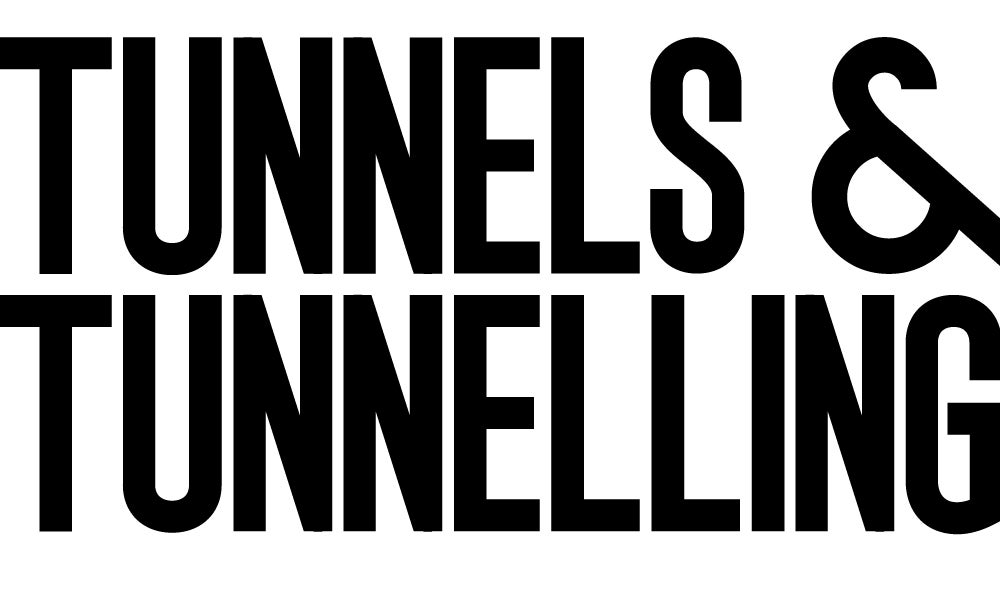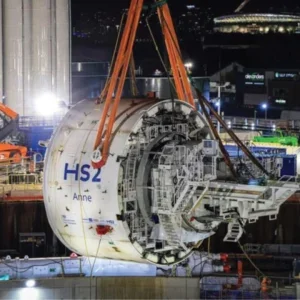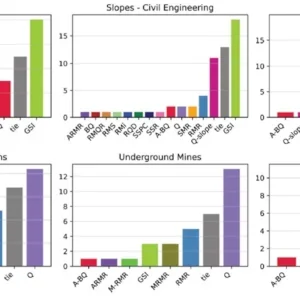Dear Sir
The first use of a vacuum type erector was on the Thyssen (GB) Ltd tunnelling contract for the Three Valleys Water Company near Heathrow Airport in the UK in 1983. The contract included construction of a 6.2km long tunnel through London Clay and lined with 685mm wide rings of expanded precast concrete segment for a 2.54m internal diameter. Each ring comprised nine ordinary plates or segments, two top segments and a wedge-shaped key at the crown to expand the ring tightly against the clay without any grouting.
An order was placed with Markham of Chesterfield to supply an open-face tunnelling shield with a backhoe excavator, conveyors to discharge muck into rail skips, and a segment erector. This was selected in preference to a fullface rotary type excavator as being the most economical solution for the length of tunnel involved, the planned outputs, and the anticipated ground conditions, which could cause clay to plug the face of a rotary type excavator.
Historically, tunnels of this type and size had been driven successfully using fullface rotary type excavators such as the Kinnear Moodie Drum Digger, but with segments erected manually. The weight of the individual segments on the Three Valleys contract, coupled with the desire to reduce manual labour wherever possible, led to design of a segment transport system to feed a mechanical erector.
The rotary-type erector supplied with the shield had steel claw grippers designed to pick up the segments from the invert and rotate them into position. Unfortunately, and despite some modifications, it quickly became apparent that such a detail would not achieve the planned production rates. The gripper system was either dropping the segment or spalling the edges with increased gripping force. The problems were exacerbated by the different geometry of the ordinary, top and key segments.
Andrew Draper, Thyssen’s Agent at the time, recalls that “while sitting in the car at the Datchet level crossing on the way home”, it occurred to him that a vacuum lifting device might work.
A quick bit of mental arithmetic based on segments weighing approximately 375lbs and a vacuum force of 12psi, a vacuum pad would require an area of 31in². For practical purposes, and with a FOS (factor of safety) of 4, the pad area would increase to 125in². (Many engineers at that time would still resort to the imperial system for mental arithmetic and some of the older ones still do!) On arriving home he said: “I jotted down a few calculations that confirmed my original thoughts.”
The following morning, he set up a meeting with Thyssen site colleagues Brian Smith, mechanical engineer for the job, Rob James, sub-agent, and Danny Travis, foreman fitter.
Draper recalls, “some, including the manufacturer, were sceptical of the idea.” However, it was decided to set up an on site trial. Draper said, “Danny was brilliant and in no time he had canabalised a vacuum pump from an old Sykes sump pump and had made a crude vacuum pad glued to a curved steel plate using draught sealant. This was rigged up in the site workshop and tried out with the help of a fork-lift truck. Somewhat to the surprise of bystanders, it worked, first time, even with someone standing on the segment!”
Things moved rapidly from there. In less than a week, the first vacuum erector with site-made vacuum pads was fitted to the shield.
The ‘lads’ on the machine thought it brilliant. Each segment needed a small hand brush sweep to remove any dirt but unlike the steel finger gripper erector, the vacuum pads did not need locating precisely on the segment and production rapidly reached the target of 25 rings/shift.
Development of purpose-made suction pads had production rates increase further. Following these demonstrations, Markham designed and produced a factory-made product. This enabled frequent production of 40 rings (90ft or 27m) per shift and a best of 54 rings, (122ft or 37m) in a single 12hr shift.
At the time, a patent application was made and subsequently granted naming Andrew Draper and Brian Smith as co-inventors.
Following this application, Markham developed vacuum erectors for several tunnelling machines in the UK. The first was for Miller Construction (now Morgan Est) for its North London Flood Relief Tunnel in Islington for Thames Water, which was under construction at the same time as Three Valleys. With the patent pending, Thyssen (GB) agreed this license.
In years to come Herrenknecht in Germany picked up and perfected the technique to lift heavier and heavier segments. The first Herrenknecht machine with a vacuum segment erector was also for a UK project. The backhoe shield was manufactured for the Docklands Light Rail tunnel connection to the Bank Underground Station in London in 1988 (see references).
Vacuum segment erectors are now the norm, if not the standard, and are vital for lifting steel-fibre reinforced segments and for building segment rings behind the mega-diameter TBMs being built today. The vacuum erector on the 15.4m Herrenknecht machine on the Chongming under river highway tunnel project in Shanghai for example is lifting segments of 20-22 tonne. Vacuum lifting devices have been used in sheet metal industries and in precast concrete factories for many decades but the multi-tonne segments for a tunnelling job can only be lifted without damage with the wide surface area lift of a vacuum erector.
And it all began as the possible solution to an irritating problem and in the Thyssen (GB) workshop of the Three Valley’s tunnel project in the UK in 1983 – unless you know differently?
Yours sincerely
Drifter
The open face backhoe for the Three Valleys Water Company tunnel The original segment erector either dropped or spalled segments The first vacuum erector with site made vacuum pads at work In full swing the new system significantly increased production The purpose made suction pads fitted to the shield DRIFTER…
The Drifter column provides a unique opportunity for readers to openly comment on industry issues whilst remaining anonymous.
Contact the editor in COMPLETE CONFIDENCE by post or email:
Tris Thomas, ‘Tunnels & Tunnelling International’, Progressive House, Maidstone Road, Sidcup, Kent, DA14 5HZ, United Kingdom
Email: tthomas@tunnelsonline.info






